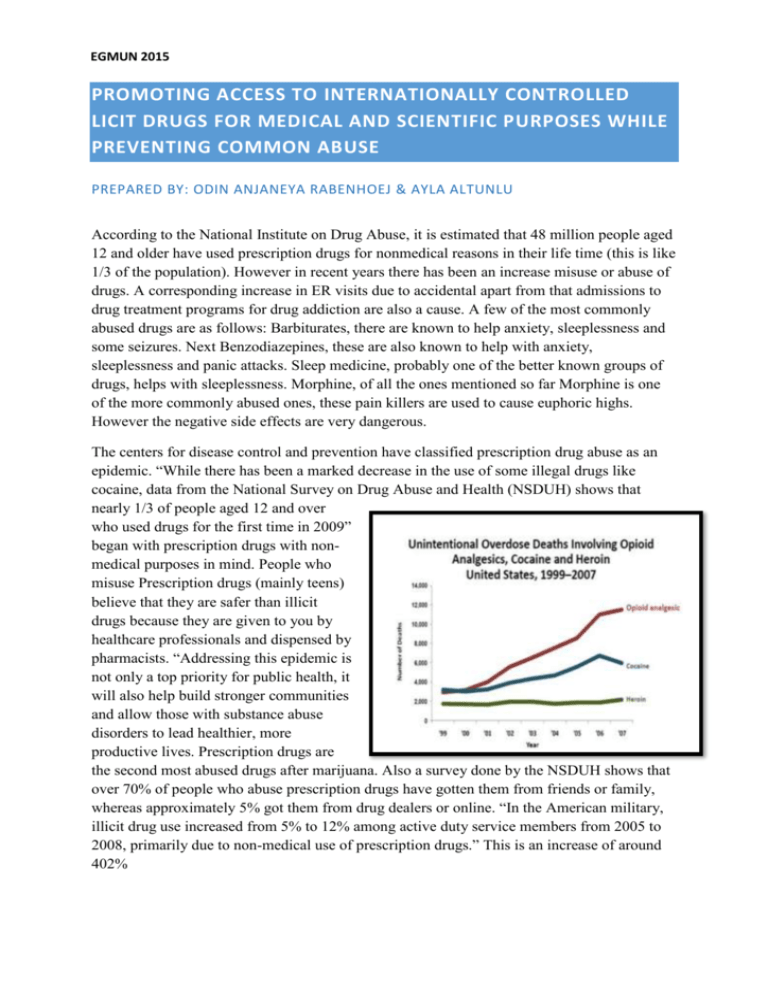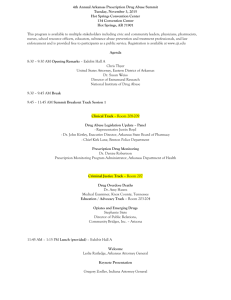Microsoft Word - Agenda report vejledning
advertisement

EGMUN 2015 PROMOTING ACCESS TO INTERNATIONALLY CONTROLLED LICIT DRUGS FOR MEDICAL AND SCIENTIFIC PURPOSES WHILE PREVENTING COMMON ABUSE PREPARED BY: ODIN ANJANEYA RABENHOEJ & AYLA ALTUNLU According to the National Institute on Drug Abuse, it is estimated that 48 million people aged 12 and older have used prescription drugs for nonmedical reasons in their life time (this is like 1/3 of the population). However in recent years there has been an increase misuse or abuse of drugs. A corresponding increase in ER visits due to accidental apart from that admissions to drug treatment programs for drug addiction are also a cause. A few of the most commonly abused drugs are as follows: Barbiturates, there are known to help anxiety, sleeplessness and some seizures. Next Benzodiazepines, these are also known to help with anxiety, sleeplessness and panic attacks. Sleep medicine, probably one of the better known groups of drugs, helps with sleeplessness. Morphine, of all the ones mentioned so far Morphine is one of the more commonly abused ones, these pain killers are used to cause euphoric highs. However the negative side effects are very dangerous. The centers for disease control and prevention have classified prescription drug abuse as an epidemic. “While there has been a marked decrease in the use of some illegal drugs like cocaine, data from the National Survey on Drug Abuse and Health (NSDUH) shows that nearly 1/3 of people aged 12 and over who used drugs for the first time in 2009” began with prescription drugs with nonmedical purposes in mind. People who misuse Prescription drugs (mainly teens) believe that they are safer than illicit drugs because they are given to you by healthcare professionals and dispensed by pharmacists. “Addressing this epidemic is not only a top priority for public health, it will also help build stronger communities and allow those with substance abuse disorders to lead healthier, more productive lives. Prescription drugs are the second most abused drugs after marijuana. Also a survey done by the NSDUH shows that over 70% of people who abuse prescription drugs have gotten them from friends or family, whereas approximately 5% got them from drug dealers or online. “In the American military, illicit drug use increased from 5% to 12% among active duty service members from 2005 to 2008, primarily due to non-medical use of prescription drugs.” This is an increase of around 402% As seen in the graph above the “Unintentional Overdose Deaths Involving Opioid Analgesics, Cocaine and Heroin”. The death rate for Cocaine and Heroin are much lower and in Cocaine’s case decreasing, However, Opioid analgesics are rising much higher than ever before. DEFINITION OF THE KEY TERMS: LICIT DRUG: LICIT DRUGS ARE ALSO KNOWN AS LEGAL DRUGS. LICIT DRUG USUALLY MEANS THAT A DRUG IS USED LEGALLY (E.G., ALCOHOL, TOBACCO AND CAFFEINE). “LEGAL USE OF DRUGS INCLUDES: - MEDICINES USED FOR ILLNESS - PRESCRIPTION MEDICINES USED BY INTENDED PERSON FOR PRESCRIBED USAGE. GENERAL OVERVIEW For many years, global consumption of narcotic drugs and psychotropic substances has been below the levels required for the most basic treatments. As a result of growing recognition of the therapeutic value of controlled substances, as well as the efforts of the international community, substantial increases in consumption have been achieved. However, while consumption levels have risen in several regions of the world, the bulk of the increase has occurred in a limited number of countries, particularly in three regions: Europe, North America and Oceania. Within some countries or regions, consumption levels have stagnated or even decreased. As long as these drugs remain inaccessible to the large majority of people around the world, patients will not be able to derive the health benefits to which they are entitled under the Universal Declaration of Human Rights. Most narcotic drugs and psychotropic substances controlled under the international drug control treaties are indispensable in medical practice. Opioid analgesics, such as codeine and morphine, as well as semi-synthetic and synthetic opioids, are essential medicines for the treatment of pain. Psychotropic substances such as benzodiazepine-type anxiolytics and sedative-hypnotics and barbiturates are indispensable medications for the treatment of neurological and mental disorders. Pharmaceutical preparations containing internationally controlled substances play an essential role in medical treatment to relieve pain and suffering. The international drug control treaties continue to be highly effective in preventing the diversion of drugs from licit to illicit markets and in protecting society from the consequences of dependence. However, in many countries equal attention has not been given to the other objective of the treaties — ensuring the adequate availability of controlled substances. Measures taken by Governments to prevent the abuse of and trafficking in narcotics drugs and psychotropic substances must not hinder the utilization of such drugs for medical treatment. Governments need to meet the dual objective of the international drug control treaties, namely, preventing the diversion and abuse of internationally controlled substances while ensuring their availability for legitimate use. This balance should be reflected in national drug control laws and regulations. While in most countries there is little or no access to opioids, in some countries, the misuse of controlled medicines represents a significant public health problem. The reason that opioids are controlled under the international drug control Conventions is the harm associated with misuse and abuse. MAJOR PARTIES The International Narcotics Control Board (INCB): is the independent and quasijudicial control organ for the implementation of the United Nations drug conventions. The National Survey on Drug Use and Health (NSDUH) provides national and state-level data on the use of tobacco, alcohol, illicit drugs (including non-medical use of prescription drugs) and mental health in the United States. UNODC: The United Nations Office on Drugs and Crime is a United Nations office that was established in 1997 as the Office for Drug Control and Crime Prevention by combining the United Nations International Drug Control Program (UNDCP) and the Crime Prevention and Criminal Justice Division in the United Nations Office at Vienna. UNODC was established to assist the UN in better addressing a coordinated, comprehensive response to the interrelated issues of illicit trafficking in and abuse of drugs, crime prevention and criminal justice, international terrorism, and political corruption. PRESCRIPTION DRUG ABUSE Narcotic pain relievers now cause or contribute to nearly 3 out of 4 prescription drug overdoses and about 15,500 deaths [annually]. Studies have shown that some people exhibit higher risk factors and may be more vulnerable to prescription drug abuse. Some factors include: Adolescents and teens who are more susceptible to peer pressure, drug experimentation, and addictive tendencies Previous substance addictions (alcohol included) Access to prescription drugs (via healthcare environments) Pre-existing psychiatric conditions The biggest area of concern however, may be in the misconceptions regarding the safety of prescription medicine. According to studies performed at the Mayo Clinic and US Department of Health and Human Services, many people, including parents, are often unaware of the dangers in providing prescribed medication to those who are not the intended patient. HOW DOES PRESCRIPTION DRUG ABUSE HAPPEN? Prescription drugs come in many forms and serve a variety of purposes. Pain relief medication may be prescribed following traumatic injury or surgical procedure. Sleep medications can be used to induce sleep or keep a person awake. Addiction often occurs when the potency and/or frequency of dosages are being used beyond their recommended instruction. For this reason, an individual may become addicted to a prescribed substance whether or not it was legally obtained. Addiction can also be caused by the body's tolerance for the medication increasing. When this change in the body’s central nervous system occurs, an increase in dosage of the substance will be required to meet the intended needs. In some cases, a physician may deem the change in prescription dosage to be necessary and make the adjustment. If a patient is denied the change in prescription however, he or she will often deviate from instruction. In cases of prescription drug abuse by unintended parties, addiction can occur during a process of substitution of one drug for another. Many of the elements and effects of prescription medications mimic those of illegal narcotics. Mood-altering stimulants like those to treat depression are also popular among social users. Other prescribed psychoactive drugs are often abused due to their ability to affect perception and consciousness. Without proper education or monitoring by a licensed physician, a user may begin a new course of prescribed medication and inadvertently take more of the medication than is instructed or required, leading to an early addiction. POSSIBLE SOLUTIONS Disposal One of the best ways to combat drug abuse and drug abusers in your own home is to follow disposal guidelines of drugs. Thus reducing the risk of unintentional harm, diversion and drug poisoning in your own home. You should learn how to properly dispose of expired drugs or un-used drugs. If necessary dispose of specific medicines as stated on their packaging. Also if the country has it one should take advantage of the medicine take-back programs. In which one takes unused drugs to a central location for proper disposal of said drug. Transfer unused medicines to registered collectors of the Drug Enforcement Administration (DEA). Such collectors could be retail, hospitals or clinical pharmacies, and even law enforcement locations. Talking to the youths Attempting to eradicate the problem closer to the beginning has a higher chance of success. Thus the kids of the world should get talked to about the risks of drug abuse in general and abusing prescription drugs. This should not be done at an age where they are too young to understand, however, they should not be too old that they have already started using it. HOW TO PREPARE AS A DELEGATE Before showing up at the conference you should have read this research report, as well as conducted your own research as to what your country’s opinion is on prescription drug abuse. Make sure you can answer the following questions: What does my country´s statistics on abuse of prescription drugs look like? How does my country try to prevent abuse of prescription drugs? Does my country allow licit drugs for purely medical and scientific purposes? Does my country do anything in the way of punishment to those found abusing said drugs? Anything else that may be relevant to the debate. READ MORE https://inpud.wordpress.com/timeline-ofevents-in-the-history-of-drugs/ https://www.unodc.org/documents/dataandanalysis/Studies/100_Years_of_Drug_C ontrol.pdf http://www.unodc.org/documents/lpobrazil/noticias/2011/03marco/Jife/Report_of_the_Board_on_the _availability_of_controlled_substances.p df https://www.unodc.org/docs/treatment/P ain/Ensuring_availability_of_controlled _medications_FINAL_15_March_CND _version.pdf http://www.drugfreeworld.org/drugfacts/ painkillers.html http://www.rehabs.com/explore/prescript ion-drug-abuse-statistics/ http://www.rehabs.com/explore/prescript ion-drug-abuse-statistics/ The 57th and 58th EU meeting on CND http://eeas.europa.eu/delegations/vienna/press_corner/news_un/2014/20140321_en.htm http://www.emcdda.europa.eu/news/2015/cnd







